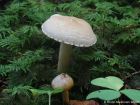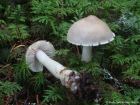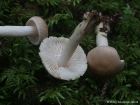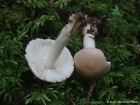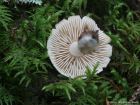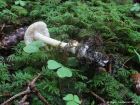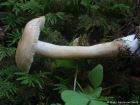Cap convex when young, gradually becoming broadly convex to nearly flat as it matures, often featuring a low, broad umbo. The surface is smooth and dull, starting pale to whitish, and often develops greyish to brownish tints with age. The flesh is white, with a pungent and disagreeable odor, sometimes reminiscent of coal tar or possessing a strong floral scent similar to hyacinths or paperwhites. Gills emarginate to adnexed, ranging from subdistant to distant, broad, white in colour and feature several tiers of shorter gills. Stem nearly equal in width, sometimes slightly enlarging downward to a swollen base that often tapers abruptly at the bottom. It is smooth and dry, with a pruinose (powdery) texture at the apex. The colour ranges from white to cream, with a brownish hue near the base. The stem has no ring. Spore print white.
Tricholoma inamoenum on the mykoweb.com Web site.
Many mushrooms are poisonous, and some can be lethally toxic. Distinguishing between edible and poisonous mushrooms can be very challenging. Therefore, we strongly advise against consuming wild mushrooms. This website does not contain any information about the edibility or toxicity of mushrooms.
Although efforts have been made to ensure accuracy on this website, the information may contain errors and omissions. Therefore, all content provided is for educational and informational purposes only and should not be relied upon or used as a basis for consuming any plants or mushrooms.
External links are provided for reference only. We do not endorse or take responsibility for the content, advice, or products found on these sites or in any advertisements shown on this website.
